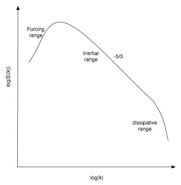Turbulence


Turbulence




In mixing of milk in coffee, wind flow near the surface of the earth, the waves in the ocean, plasma motion on the surface of the stars, near airplane wings, the flow velocity is typically large, and the velocity field is random. All these systems are described by seemingly simple looking equation called Navier-Stokes equation. For over a century scientists, mathematicians, and engineers have attempted to understand the dynamics of turbulent flow. Yet the problem remains largely unsolved. As an example, so far we cannot compute the drag experienced by an airplane from the first principle. For a simple description of some of the issues involved, refer to a general article on turbulence.
Kolmogorov gave one of the first analytic theory of turbulence in 1941. According to this theory, the physics of turbulence is the same in all turbulent systems in the intermediate range, and it is independent of the large-scale forcing mechanisms and the small-scale dissipative processes. He also assumed a constant energy flow (called energy cascade rate or energy flux) from the large scales to the intermediate scale, and then to small scales. With the above ansatz, the energy spectrum of the fluid comes out to be E(k) = KKo ∏2/3 k-5/3, where KKo is Kolmogorov's constant which has been found to be nearly 1.5 (see above figure). The amazing thing about this spectrum is that it is universal, that is all turbulent flows (atmosphere, pipe flow, shear flow, liquid flow, magnetohydrodynamic plasma) have the above energy spectrum. The above spectral exponent -5/3 has been observed in many experiments and numerical simulations apart from a correction called intermittency correction, which is approximately 0.04.
Intermittency remains one of the unsolved mysteries in turbulence research. It is related to higher-order structure functions (similar to higher-order correlations). These issues are being investigated using experiments, simulations, and analytic tools. There are other very important and unresolved issues like coherent structures, boundary layers, shear flows, anisotropy etc. You could browse through the turbulence link to read about these topics.
We have investigated energy spectrum, energy fluxes and other energy transfers for magnetohydrodynamic turbulence, and showed that the physics of magnetohydrodynamics turbulence is also Kolmogorov-like with spectral exponent being -5/3 . At present we are exploring turbulence convection, dynamo, and liquid metals.
